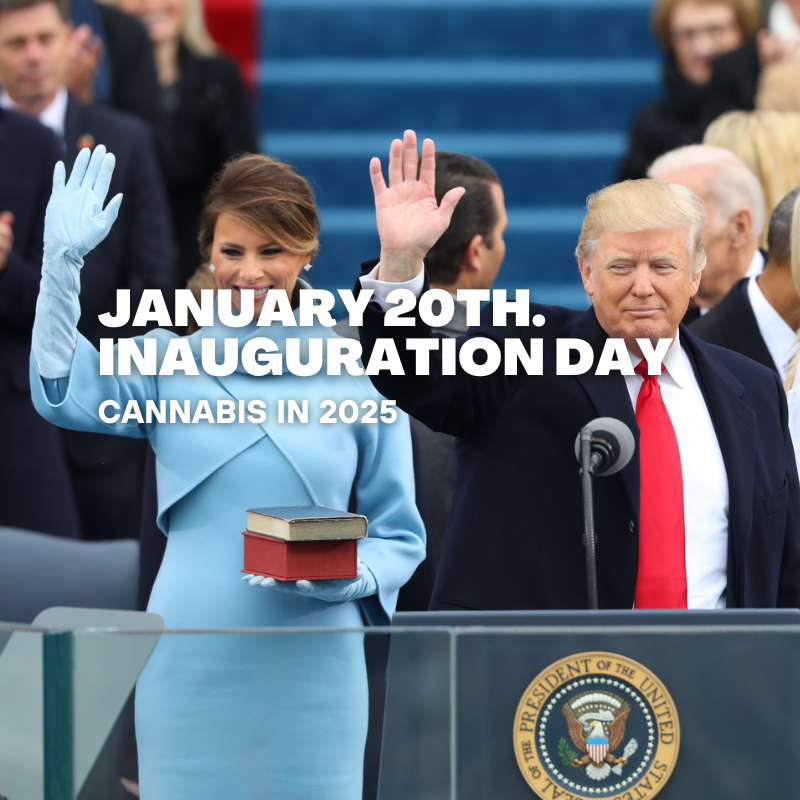Inauguration Day 2025: Reflecting on Trump’s Impact on Cannabis and What Lies Ahead
As the nation marks Inauguration Day 2025, we not only celebrate the transition of leadership but also take a moment to reflect on the political forces that have shaped the landscape of American industries—especially the rapidly growing cannabis industry. One figure who has had a lasting influence on cannabis policy in recent years is Donald Trump.
While Trump’s tenure as president was marked by a complex relationship with cannabis reform, his legacy is undeniable in shaping the trajectory of cannabis legalization in the U.S. On this Inauguration Day, it’s important to look back on Trump’s cannabis-related policies, how they impacted the industry, and what we might expect moving forward as a new administration takes office.
1. Trump’s Legacy: Shaping Cannabis Policy Through the Lens of States’ Rights
One of the most defining aspects of Trump’s cannabis policy was his support for states’ rights. During his time in office, Trump largely allowed states to forge their own paths when it came to cannabis legalization. Whether it was medical marijuana, recreational use, or hemp products, the Trump administration refrained from using federal power to impose restrictions on states that had chosen to legalize cannabis.
Key Moments of Trump’s Influence on Cannabis:
- Jeff Sessions and the “Sessions Memo”: Early in Trump’s presidency, the appointment of Jeff Sessions as Attorney General caused concern for the cannabis industry. Sessions was a staunch opponent of cannabis legalization and rescinded the Cole Memo in 2018, which had previously advised federal prosecutors to avoid interference in states with legal cannabis programs. However, despite Sessions’ views, Trump’s hands-off approach allowed state-legal cannabis markets to flourish.
- The “States’ Rights” Doctrine: Trump’s administration supported states’ rights, meaning that if a state like California or Colorado chose to legalize cannabis, the federal government would not intervene. This allowed the cannabis industry to thrive at the state level. More than 30 states legalized cannabis in some form during his presidency, contributing to the economic boom in legal cannabis markets across the country.
- The 2018 Farm Bill: Trump signed the 2018 Farm Bill into law, which legalized hemp and CBD products derived from hemp. This was a monumental step for the cannabis industry, as it led to the proliferation of hemp-derived CBD products in the market. The bill opened up new business opportunities, creating a multi-billion-dollar industry in hemp cultivation, extraction, and product development. CBD products became a cornerstone of wellness trends during Trump’s presidency, leading to widespread use in skincare, pain relief, and even pets.
2. The Cannabis Industry Under Trump: Growth and Challenges
Despite the federal government’s ambivalence toward cannabis, the industry saw tremendous growth during Trump’s tenure. Cannabis became a multi-billion-dollar industry, driving job creation, tax revenue, and innovation in agricultural and consumer goods markets.
Economic Growth and Challenges:
- State-Level Legalization: By 2025, more than 20 states had legalized recreational cannabis, with several others embracing medical marijuana programs. States like California, Colorado, Illinois, and New York generated billions in cannabis tax revenue. These states allocated funds for education, healthcare, and infrastructure improvements. Under Trump, the expansion of state-level legalization helped cannabis become a mainstream industry with wide public acceptance.
- Job Creation: The cannabis sector created hundreds of thousands of jobs, from cultivation and manufacturing to retail and distribution. By 2025, the industry is projected to employ over 400,000 people, making it one of the fastest-growing job sectors in the U.S. Trump’s hands-off federal approach gave states the autonomy to grow their cannabis markets, contributing to this employment boom.
- Challenges of Banking: Despite these gains, cannabis businesses faced a significant challenge during Trump’s administration—banking. Because cannabis remained illegal at the federal level, cannabis businesses were forced to operate in cash-only environments, creating safety issues and barriers to financial services. While Senate bills like the SAFE Banking Act were introduced to ease banking restrictions for cannabis businesses, Trump’s administration largely ignored the issue. This remains a key concern for the cannabis industry in 2025.
3. Trump and the Cannabis Debate: Polarizing Opinions and Political Resistance
While Trump’s policies were generally viewed as hands-off when it came to cannabis, his views on the subject remained complex and often contradictory. Throughout his presidency, Trump expressed mixed feelings about cannabis legalization, reflecting a broader divide within the Republican Party on this issue.
Key Moments of Political Resistance:
- Opposition to Legalization: During his 2016 campaign, Trump was openly opposed to legalizing cannabis at the federal level, although he suggested that it should be left to states. However, as states like California and Colorado saw success with legalization, Trump’s rhetoric softened, and he allowed states to move forward with their own cannabis laws without federal interference.
- Trump’s Contradictory Comments: Trump made several contradictory statements regarding cannabis, further polarizing opinions on the matter. At times, he suggested cannabis might be a dangerous drug, while at other times, he praised the economic benefits of state-level legalization. These mixed messages left the cannabis community uncertain about what would happen if he remained in office for a second term.
- The War on Drugs and Social Justice: While Trump did not prioritize cannabis reform in the context of social justice, his administration did take some steps toward criminal justice reform with the First Step Act, which addressed sentencing disparities for nonviolent drug offenders. However, many advocates felt that more could have been done to rectify the damage caused by the War on Drugs—particularly for minority communities disproportionately impacted by cannabis prohibition.
4. What’s Next for Cannabis in 2025 and Beyond?
As we enter 2025, the cannabis industry finds itself at a pivotal moment. With a new president in office, the question on everyone’s mind is whether cannabis legalization will continue to be shaped by states’ rights or whether we will see federal reform that could change the game entirely.
What to Expect in 2025:
- Federal Decriminalization and Legalization: The Trump administration left the cannabis issue largely in the hands of the states, but the new administration may take a different approach. Federal decriminalization or even full legalization could be on the horizon. With growing public support for cannabis, it’s possible that the new president will push for a more unified national cannabis policy.
- Cannabis Banking Reform: One area of focus in 2025 will likely be addressing the cannabis banking problem. While the SAFE Banking Act has passed in the House, it still faces obstacles in the Senate. If the new administration prioritizes banking reform, it could provide a huge boost to cannabis businesses across the country, allowing them to operate more freely and access capital.
- Social Justice Programs: The cannabis industry in 2025 is also expected to see an increase in social justice programs aimed at helping communities affected by cannabis prohibition. The equity programs for minority-owned cannabis businesses, expungement of past convictions, and workforce development initiatives could be at the forefront of reform efforts.
Conclusion: Trump’s Lasting Influence on Cannabis Policy
As we look ahead to a new chapter on Inauguration Day 2025, it’s clear that Donald Trump’s influence on cannabis policy will continue to reverberate throughout the industry. While his presidency did not lead to federal legalization, his policies paved the way for an unprecedented expansion of state-level cannabis programs, contributing to the industry’s economic boom.
As a new administration takes office, the future of cannabis policy remains uncertain, but one thing is for sure: Trump’s legacy in the cannabis space is significant, and his hands-off approach to cannabis will be a defining factor in how the industry grows in the years to come.
Stay updated on how cannabis legalization and policy continue to evolve in 2025. Subscribe to our blog for the latest news, trends, and analysis of the cannabis industry.







